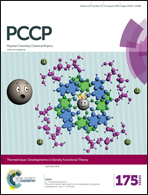Conformational selection underpins recognition of multiple DNA sequences by proteins and consequent functional actions†
Abstract
Recognition of multiple functional DNA sequences by a DNA-binding protein occurs widely in nature. The physico-chemical basis of this phenomenon is not well-understood. The E. coli gal repressor, a gene regulatory protein, binds two homologous but non-identical sixteen basepair sequences in the gal operon and interacts by protein–protein interaction to regulate gene expression. The two sites have nearly equal affinities for the Gal repressor. Spectroscopic studies of the Gal repressor bound to these two different DNA sequences detected significant conformational differences between them. Comprehensive single base-substitution and binding measurements were carried out on the two sequences to understand the nature of the two protein–DNA interfaces. Magnitudes of basepair–protein interaction energy show significant variation between homologous positions of the two DNA sequences. Magnitudes of variation are such that when summed over the whole sequence they largely cancel each other out, thus producing nearly equal net affinity. Modeling suggests significant alterations in the protein–DNA interface in the two complexes, which are consistent with conformational adaptation of the protein to different DNA sequences. The functional role of the two sequences was studied by substitution of one site by the other and vice versa. In both cases, substitution reduces repression in vivo. This suggests that naturally occurring DNA sequence variations play functional roles beyond merely acting as high-affinity anchoring points. We propose that two different pre-existing conformations in the conformational ensemble of the free protein are selected by two different DNA sequences for efficient sequence read-out and the conformational difference of the bound proteins leads to different functional roles.


 Please wait while we load your content...
Please wait while we load your content...